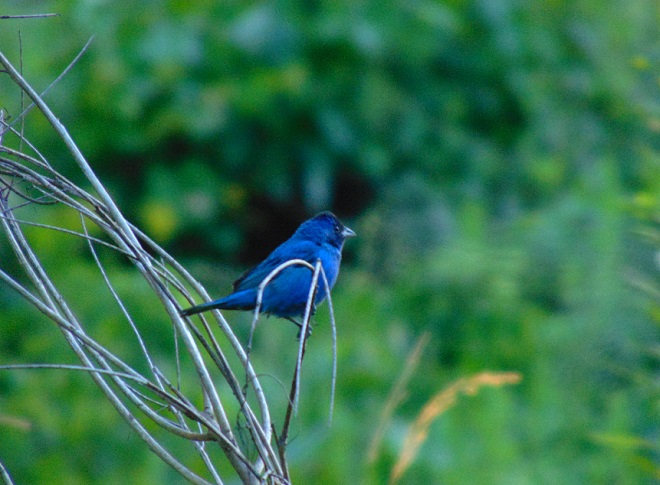Let’s imagine that you spend your summer as a singer and you have to strut your stuff in a blue suit all day long just so the other guys know that you’re not going to tolerate any nonsense with either of your two gals. And…you’re responsible for feeding the adolescent kids while each of the girls begins a second family. Wouldn’t you be ready for a break by late August?
The boys must think so. They’re quiet now. This week was the end. They’ve done their duty. They protected their homes and got the youngsters out on their own. It’s time to eat, get out of the dress blues, and prepare to take a flight to warmer climates, maybe even the tropics…for a holiday of sorts.
The male Indigo Bunting (Passerina cyanea) has a busy schedule. Before arriving at Conewago Falls in early May, he has molted from the plainest of plain brown plumage and donned an iridescent set of feathers that glow a brilliant blue and purple in sunlight. He chooses a territory with plenty of shrubby and weedy growth along the edge of a woodland, and begins to sing and defend his parcel, often from a dead tree or other perch.
At Conewago Falls, the Indigo Bunting is a common breeding bird, finding the mosaic of electric transmission wire right-of-ways, railroads, and the Riverine Grasslands to be absolutely perfect habitat. The female, inconspicuous in her uniformly brown plumage, builds the nest, incubates the 3 to 4 eggs (11 to 14 days), and feeds the young in the nest (9 to 12 days). Being quite the showboats, some males will have more than one mate nesting in their territory. In addition to defending the nest(s), the male Indigo Bunting will sometimes feed the fledged young so that the female(s) can begin incubating a second brood. The summertime diet is mostly invertebrates, but seeds are also consumed.

By late August, the young of the year are mostly on their own. The male’s territorial urges, including the nearly non-stop singing, come to an end. Soon, his blue feathers are beginning to drop and a molt is underway into a brown plumage resembling that of the females and juveniles.
Indigo Buntings evacuate their breeding range in eastern North America to winter mostly south of the United States. These nocturnal travelers have been the subject of migration behavior studies. They are among a number of small bird species known to cross the Gulf of Mexico on their way south. Also, Indigo Buntings can navigate by the stars.
On the wintering grounds, Indigo Buntings are flocking birds. At this time of year, they consume more seeds as a component of their diet and are known to visit bird feeders.
By April, the blue suit is back, and the males and females are on the way north. Hope to see you then pal.
SOURCES
Dunne, Pete. 2006. Pete Dunne’s Essential Field Guide Companion. Houghton Mifflin Company. New York.
Kaufman, Kenn. 1996. Lives of North American Birds. Houghton Mifflin Company. New York.
